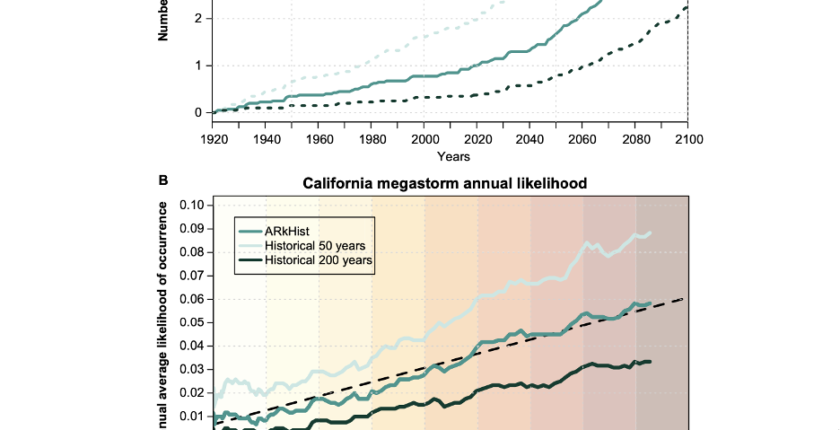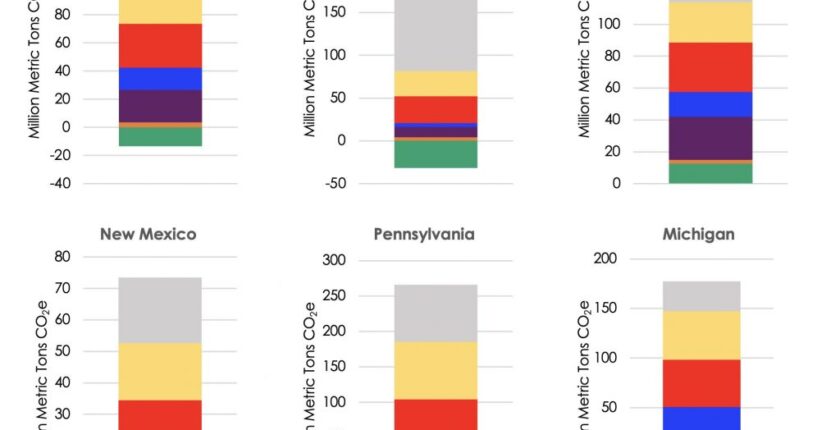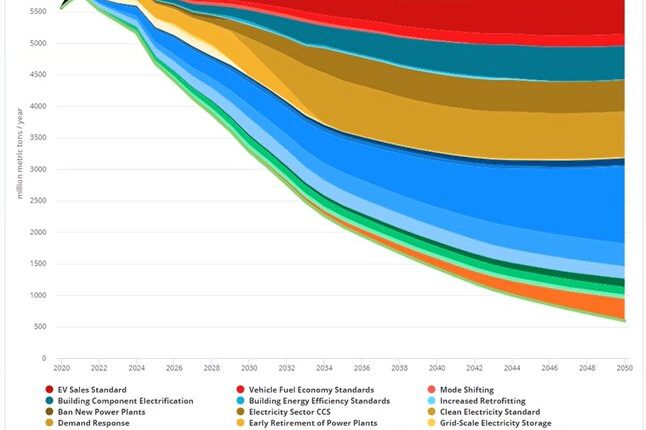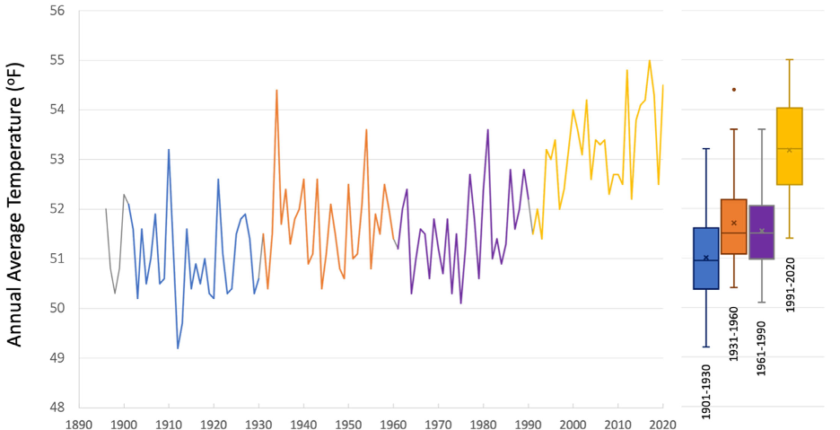Energy Innovation partners with the independent nonprofit Aspen Global Change Institute (AGCI) to provide climate and energy research updates. The research synopsis below comes from AGCI Community Science Manager Elise Osenga. A full list of AGCI’s updates is available online at https://www.agci.org/solutions/quarterly-research-reviews.
California is currently living out the old adage, “It never rains but it pours.” Following years of severe drought across the western United States, atmospheric rivers began sweeping into the state last December, bringing intense rain and snowfall. Throughout the new year and into the following months, storms continued to slam both Northern and Southern California with intense precipitation.
This March, rainstorms caused flooding, mudslides, and a levee breach at low elevations. In California’s Sierra Nevada range, snowpack reached as much as 269 percent of “normal” in some locations by the end of February (compared to 1991-2020), with extreme snowfall collapsing structures and closing highways. Concern is also rising that this year’s deep snow could produce even more intense flooding as warmer spring temperatures create snowmelt runoff and precipitation switches from snow to rain at higher elevations.
This is a far cry from 2022, when California recorded its driest January, February, and March in over a century, and drought records were set across the western U.S. Similar trends are observable around the world. The European Alps have seen declining average annual snow cover since 1971—a trend unprecedented in the last 600 years. Multi-year droughts have also created challenges in South America (although heavy snows in July 2022 brought some relief to the Andes in Chile and Peru).
Snowpack is of utmost concern in mountain communities, where it affects everything from flower blooms to wildlife survival and from recreational economies to municipal and agricultural water supplies. As the impacts of climate change intensify, experts predict fundamental shifts in mountain hydrologic cycles, with consequences for snow-reliant people and ecosystems. Understanding what those alterations will look like is a complex challenge. California can serve as a case study to help connect the dots between rising temperatures and regional atmospheric patterns and to reconcile forecasts of a future that brings both more extreme droughts and more extreme floods.
Atmospheric rivers and megafloods in a high-risk future
One of the largest determinants of winter precipitation is the season’s pattern of atmospheric rivers. Corridors of air that contain high amounts of water vapor, atmospheric rivers flow from near the equator to higher latitudes, typically bringing high wind speeds and heavy rainfall or snow—especially when they encounter mountainous terrain.
Recent research from Huang et al. (2022) warns that climate change impacts to atmospheric rivers in the Pacific could combine with a warming-driven shift in precipitation falling as rain rather than snow to increase the likelihood of massive flooding in California. Running ARkStorm 2.0, a disaster scenario program for California, and using various future climate conditions, Huang et al. found that for each 1 degree Celsius increase in global atmospheric temperatures, California saw a rapid increase in the likelihood of a historic megaflood on par with California’s Great Flood of 1861-1862 (Figure 1).
Warmer temperatures and increased flood risk are linked by both the intensity of precipitation events and whether the precipitation falls as rain versus snow. Warmer air can hold more water vapor than cool air, and this study found that as the atmosphere warms, more atmospheric rivers will carry moisture loads that can generate extreme precipitation in the western U.S.—a finding supported by other studies, including Kirchmeier-Young and Zhang (2020), Michaelis et al. (2022), and Corringham et al. (2022).
Furthermore, flood risk associated with intense precipitation events may be regionally compounded by the impacts of warmer temperatures. Huang et al. found warming temperatures were associated with a greater proportion of the increased precipitation falling as rain rather than as snow. Under a high-emissions climate change trajectory, the probability of a megaflood on par with the Great Flood of 1861-1862 more than triples by 2060, marking a 600 percent increase in risk.
Reconciling a future that is both wetter and drier
How does a more flood-prone future square with studies that predict a drier future for California and elsewhere and the oft-discussed “aridification of the American West”? Again, atmospheric rivers and regional warming play a role.
Research from NASA indicates that although warmer air temperatures may contribute to wetter and more intense atmospheric rivers, the total number of atmospheric rivers bringing precipitation (of any quantity) to the western U.S. may decrease—meaning fewer significant, water-providing storms. When meteorological droughts (droughts caused by below average precipitation) do occur, they’re likely to be exacerbated by the warming climate, with impacts to both summer and winter hydrologic cycles.
So what will these changes mean for future snowpack? A recent study by Weider et al. (2022) projects snowpack volume could decline over the coming century across the Northern Hemisphere. This study assessed potential changes to seasonal snow cycles in multiple mountainous regions by using a set of 40 simulations from a global climate model to better understand the range of possibilities. Comparing projections for 2070-2099 to a 1950-1969 baseline, the researchers classified areas where greater than 3 cm of snow were present for more than three months at a time.
They found that warmer future climate scenarios were associated with thinner and less widespread snowpack by the year 2100, although changes to snowpack were not evenly distributed across the hemisphere. This decline in snowpack was in turn associated with a decrease in the number of days with freezing temperatures, leading to a shorter snow season. Additionally, Weider et al. found a shift in timing, with more runoff and peak streamflow earlier in the calendar year and a greater percentage of snow melt occurring before the peak snow water equivalent (SWE) for previous decades (Figure 2). These timing changes create challenges for water management.
Figure 2. These maps from Weider et al. (Figure. 4 in the paper) compare modeled changes in the amount of winter snow melt occurring before peak SWE (a proxy for date of peak snowpack) from 2000 to 2100 [snow melt fraction–left] and the point in the year at which 50 percent of annual streamflow has occurred [change center timing-right]. By 2100, a larger percentage of snow melt occurs earlier in winter, and runoff shifts to earlier in the year.
Looking ahead to 2100, a study by Rhoades et al. (2022) also projects declining snowpack within the American Cordillera, a series of mountain ranges across western North and South America that includes California’s Sierra Nevada. The study compared high-resolution models to identify events where SWE fell below the 30th percentile compared to average historical snowpack. Rhoades et al. found that parts of the Cordillera consistently fell into low- to no-snow values for the second half of this century, with the low-snowpack trend beginning to emerge as early as 2025. Similar to Weider et al.’s findings, changes to the Cordillera snowpack were tied in part to an increase in temperature, which translated into fewer days below freezing and a larger proportion of precipitation falling as rain rather than snow.
As noted by Weider et al., warming-driven shifts in quantity and timing of snowmelt create challenges for water managers, because when a larger proportion of runoff comes from rain instead of snow, timing of water supplies becomes less predictable. Additionally, there is much still to learn regarding broader cascading impacts across ecological and freshwater systems and how these relate to human systems (including food production, recreation, and water quality).
Preparing for the future
Collectively, these studies paint a picture of a future California marked by less snow on average than in historic periods, punctuated by episodic extreme precipitation events. The magnitude and pace of changes may be determined by emissions pathways, but multiple studies show that even under low-emissions scenarios, California and other locations dependent on snowpack for their water will face conditions for which historical records cannot provide a template.
As water supplies tied to snowpack are projected to become less predictable in quantity and timing, Rhoades et al. emphasize the increased importance of adaptive water storage infrastructure and innovative management approaches, particularly for regions that lack such infrastructure. Meanwhile, Huang et al.’s prediction of increased megastorms demonstrates a different kind of challenge for water infrastructure and building codes: preparedness for floods and extreme precipitation events. Proactive thinking and designing for both wetter and drier conditions may aid in planning for a future that differs from the past.
Wieder et al. emphasize the need to think beyond human infrastructure, noting that understanding feedbacks between ecological systems and snowpack will be essential to effective adaptation approaches for mountain communities. Rhoades et al. also emphasize the importance of developing “conceptual frameworks”—analytical approaches that identify connections between system variables.
Whether preparing for drought or excess water, findings from across all studies indicate that high-emissions scenarios will accelerate and exacerbate hydrologic changes. Rhoades et al. find that the rate of carbon emissions determines how soon low- to no-snow conditions emerge, while Huang et al. find that risk of extreme flooding increases with each degree of atmospheric warming, even when the climate has already warmed. Corringham et al. similarly find that impacts in the western U.S. differ by climate scenario: the ~$1 billion/year average spending on atmospheric river-related flood damage over the past 40 years doubles under an intermediate-emissions scenario (RCP4.5) but more than triples under a high-emissions scenario (RCP8.5). Consequently, the speed and scale of climate warming will play a significant role in determining recurrence of catastrophic events in the coming decades. Collectively, these studies indicate that successful climate mitigation activities carried out now can dramatically reduce the severity of future impacts from atmospheric rivers, floods, and droughts.
Featured research:
Carrer et al., “Recent Waning Snowpack in the Alps Is Unprecedented in the Last Six Centuries,” Nature Climate Change 13 (2023): 155-160, https://www.nature.com/articles/s41558-022-01575-3.
T.W. Corringham et al., “Climate Change Contributions to Future Atmospheric River Flood Damages in the Western United States,” Scientific Reports 12 (2022), https://www.nature.com/articles/s41598-022-15474-2.
Huang and D.L. Swain, “Climate Change Is Increasing the Risk of a California Megaflood,” Science Advances 8, no. 32 (2022), https://www.science.org/doi/full/10.1126/sciadv.abq0995.
M.C. Kirchmeier-Young and X. Zhang, “Human Influence Has Intensified Extreme Precipitation in North America,” PNAS 117, no. 24 (2020), pnas.org/doi/10.1073/pnas.1921628117.
A.C. Michaelis et al., “Atmospheric River Precipitation Enhanced by Climate Change: A Case Study of the Storm that Contributed to California’s Oroville Dam Crisis,” Earths Future 10, no. 3 (2022),https://agupubs.onlinelibrary.wiley.com/doi/full/10.1029/2021EF002537.
A.M. Rhoades et al., “Asymmetric Emergence of Low-to-No Snow in the Midlatitudes of the American Cordillera,” Nature Climate Change 12 (2022): 1151–1159, https://doi.org/10.1038/s41558-022-01518-y.
W.R. Weider et al., “Pervasive Alterations to Snow-Dominated Ecosystem Functions Under Climate Change,” PNAS 119, no. 30 (2022), https://www.pnas.org/doi/abs/10.1073/pnas.2202393119.
The post Atmospheric Rivers, Floods, And Drought: The Paradox Of California’s Wetter And Drier Climate Future appeared first on Energy Innovation: Policy and Technology.
As the impacts of climate change intensify, experts predict fundamental shifts in mountain hydrologic cycles, with consequences for snow-reliant people and ecosystems. California can serve as a case study to help connect the dots between rising temperatures and regional atmospheric patterns.
The post Atmospheric Rivers, Floods, And Drought: The Paradox Of California’s Wetter And Drier Climate Future appeared first on Energy Innovation: Policy and Technology.[#item_full_content]








